Cervical disc bulges can be a very painful condition. However, this condition can resolve very quickly with the proper at-home care. In this post, I'm going to give some tips for at-home care that can help a cervical disc bulge get better very quickly. If you know that you're dealing with a cervical disc bulge, follow these instructions - and you could be pain-free in no time.
The first part of managing a cervical disc bulge is to understand what's going on. The discs in our spine are similar to a jelly donut. There is a hard outer shell with a gel center. This allows our discs to act as a cushion for the forces that go through our spine; they act as shock absorbers. Without our discs' protection, anytime we fell down, or had a hard bump into something, we would be at risk of compression fractures in our spine. Our discs help to absorb the force of these various blows, and they keep that force from being focused into the bones of our spine.
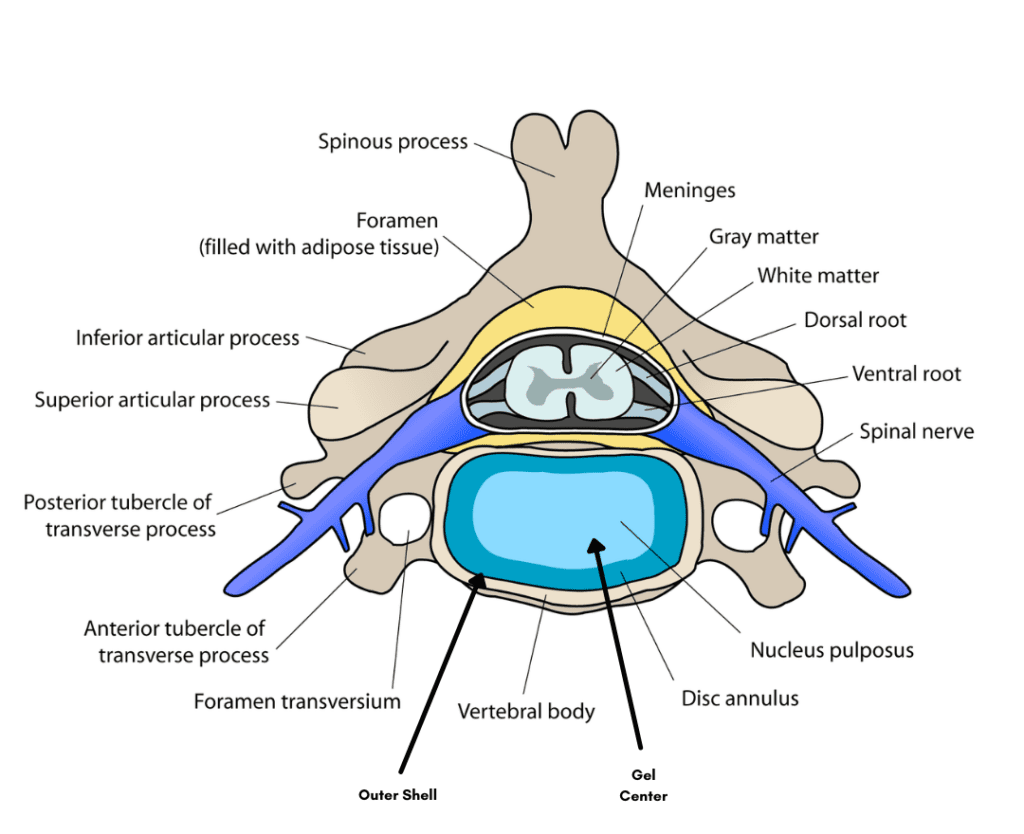
The structure of the disc actually moves with our spine. The gel and the center of the disc is called the nucleus pulposus. Whenever we bend our spine forward, that gel is pushed to the back of the disc and whenever we bend our spine backwards, the gel moves to the front of the disc.

If you think about it for a minute, you can see that most of our daily habits - things like computer usage, usage of cell phones and tablets, reading, and many others - cause our Cervical spine to bend forward. Very few of our common daily habits bend our Cervical spine backwards. Due to this mismatch in movement of our spine, the gel in the center of many of our discs, over time, can start to migrate towards the back of the disc. This eventually starts to put pressure on the outer shell of the disc in the back.
Eventually, this will start to weaken the outer shell and can lead to a bulge in the back of the shell. When this happens in our neck, it's referred to as a cervical disc bulge. This can cause pain and irritation in the neck and tightness in the muscles of the neck.
The other symptom that can be very painful when experiencing a cervical disc bulge is pain in the nerves that go into our arm. When the disc starts to bulge in the back, it can come into contact with the nerves that exit our neck, leading into our arms. This bulging can lead to pain, numbness, tingling, burning, and weakness in the arm.
The proper home care will often allow Cervical Neck Bulges to get better very quickly. Below, I'm listing the best tips for things to do at home that can help you feel better as quickly as possible.
The nerves in our neck react to inflammation differently than the nerves in our low back. The discs in our neck are prone towards excessive inflammation. Scientists have shown in research studies that the nerves in our neck can swell up to twice their normal size when in the presence of inflammation. This can make them twice as likely to get pressed on during a cervical disc bulge.
I often explain disc injuries to my patients as being similar to getting a cut on your knuckle. If you have a cut on your knuckle and you continually bend your finger all day long, the scab gets ripped open multiple times a day - clearly, it will take longer to heal.
A similar effect happens with disc injuries. Since bending our spine forward pushes the gel to the back -- then, every time you bend your spine forward while you have an irritated disc, that bending will cause the disc to become further irritated. This can lead to a constant cycle of pain.
So - when you have a Cervical Disc Bulge, after you've taken actions to STOP the Inflammation, the next tip for you is to limit how often you bend your neck forward (this stops "the scab" from reopening).
This tip alone can be a miracle that helps decrease/eliminate pain during a cervical disc bulge.
Once you quit "picking the scab" each day, you'll notice the pain start to get better very quickly. The next step is to start to move the gel in the disc back to the center.
To do this, we have to use the motion of our spine to accomplish it. As I mentioned above, bending our spine forward too much moves the gel to the back. So in order to move the gel forward to the center, we have to bend our spine backwards often.
To do this, we use an exercise called a chin retraction. In the video above, you'll see this exercise demonstrated. You need to sit up tall and pull your chin backwards like you're giving yourself a double chin. Once you've moved your chin back as far as you can using the muscles of your neck, you will use two fingers on your chin to push your spine backwards even more. If you are having nerve pain going down into the arms, you want to make sure that you use two fingers of the arm that is not painful when you do this exercise.
When you do this action, the gel in the disc gets pushed to the back -- finally, after many years of bending our spine forward more than we've been bending it backwards. So in order to effectively reposition that gel correctly now, we have to bend our spine backwards a lot. At the beginning of a cervical disc bulge, you will want to do 10 of these chin retractions every two hours that you're awake.
The final tip is to get the pressure off the nerves.*
*This tip should only be used if you're having nerve symptoms in one of your arms. When the disc presses on your nerves, it can change the way your nerves move in your arm when you're doing daily tasks.
There are usually three main nerves that can be affected when we have arm pain during a cervical disc bulge. These are the median nerve, the radial nerve, and the ulnar nerve. In order to improve how these nerves move, you would use the exercises shown below.
Each of these three nerves supplies different parts of your arm with sensation.
Note: You would want to do the exercises 1 to 2 times a day and do 10 repetitions each time. These exercises can greatly diminish the symptoms in the arm especially when paired with the chin retractions.
So there you have it! Cervical disc bulges can create a very painful and debilitating condition.
But they can also resolve very quickly if managed correctly. If you know you are dealing with a cervical disc bulge, try these tips and you may likely find that your pain gets better very rapidly!
If you try these tips and are still in pain, your best course of action is to get treatment.
We treat these conditions every day at Movement Laboratory and are very successful at resolving this injury without surgery. Give us a call at 918-300-4084 and schedule an appointment today to let us help you with your cervical disc bulge!
By: John H. Keefe IV, D.C.


The Neck Assessment is part of my new blog series, titled ----"Check Yourself Before You Wreck Yourself". In this series, I will be teaching mobility self-assessments and corrective exercise stretches. You will learn how to check the function of different areas of your body. If you find a problem, I will teach you step-by-step how to improve the movement in these areas.
Today I want to demonstrate three self-assessments for the neck. Those are:
The first self-assessment/test - for Neck Flexion - is shown in the video above. The goal of this assessment is to be able to touch your chin to your chest without separating your teeth (opening your jaw) in order to accomplish that.
This is a test that many people will not be able to do. Many of us, due to sitting and working on computers or looking at our other technology, become tight in areas that restrict this motion.
An inability to pass this test means that you are at increased risk for neck pain in general. You're possibly also prone to getting tension headaches, migraines, and jaw pain. If you're unable to pass this test, try the corrections listed below.
The first correction is shown in the video above. It requires the use of a "peanut" which is made by simply taping either two tennis balls or two lacrosse balls together.
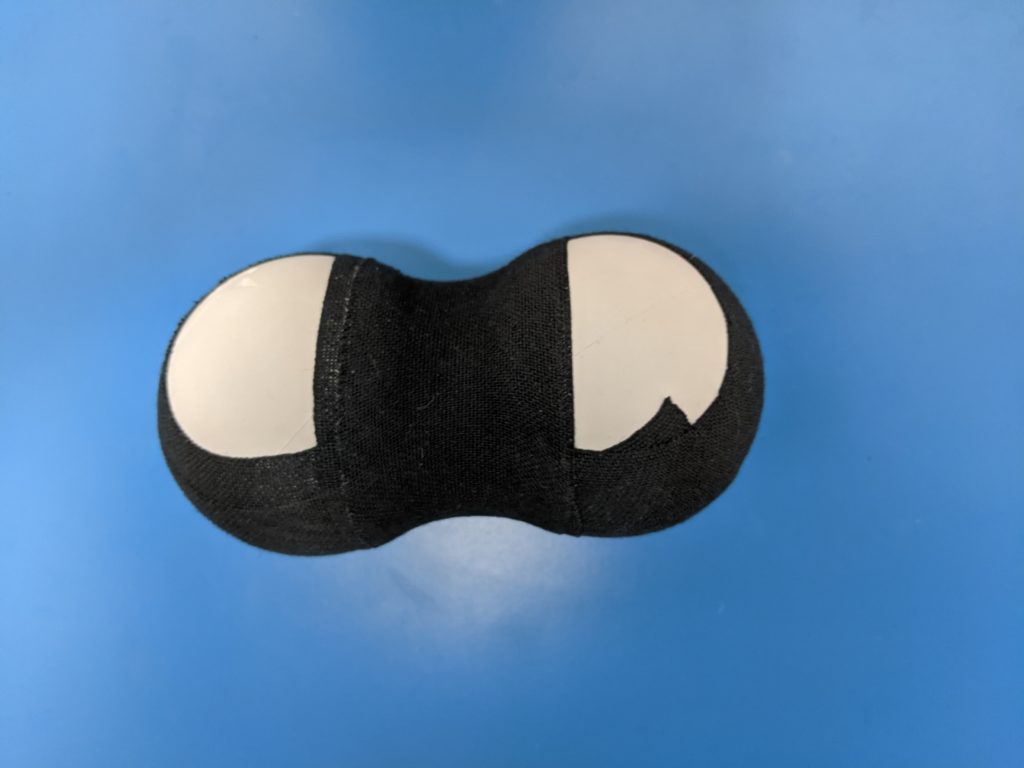
There are two main muscle groups we want to target to help improve the Neck Flexion range of motion. The first are the muscles at the base of your skull.
Once you have finished this corrective action, repeat the test. You'll notice that you'll be able to bring your chin down closer to your chest.
Doing this once may not immediately enable you to pass this test, but if you work at it for just a week or two, you will likely be able to pass the test.
The second self assessment looks at your ability to rotate your head from side to side. For this test, you're going to slowly turn your nose one direction as far as you can. Once you get as far as you can, try to bring your chin downwards to touch your collarbone. To pass this test, you should be able to touch your chin to about the middle of your collarbone on each side.
The muscles that restrict this movement are very commonly indicated in general neck tightness, neck pain, and tightness due to stress. If you're unable to pass this test, try the corrections below.
Once you finish this stretch, repeat the self-assessment. Like I said with the first self-assessment, doing this once may not immediately enable you to pass the test - but if you work on these stretches for at least 2 weeks, you should see great improvement on this test!
So there it is. That's my first entry for this new blog series entitled "Check Yourself Before You Wreck Yourself!" Make sure you stay tuned to future blogs for the next part in this series. The things you'll learn will allow you to take control of how your body moves and help you to eliminate pain yourself!
SPECIAL OFFER!
"Check Yourself Before You Wreck Yourself" Course - Available here on my Website under "Courses" Tab
In collaboration with Zac King, I have an extended online course of the same name for anyone who is interested. This course has many self-assessments for the rest of the body and self-corrections to help improve any areas that are problematic. We're offering a special promotion for anyone who would like to sign up for the course and get $10 off! --- That makes the Entire Course only $29.99!
Get signed up today if you want to take control of your movement and eliminate pain on your own! Click the following link to sign up today: https://movlabtulsa.com/courses/
And don't forget - if you run into any issues, or if your neck isn't responding as you wish, MovLab is here to help at any point in your neck rehab work - Mobility is our specialty! Just call us at 918.300.4084 to schedule your next appointment - you'll be glad you did!
Many of you have experienced the following situation.
Maybe your neck wasn't hurting at all - or maybe it hurt just a little bit, ... and then you lay down to go to sleep. But - when you woke up, your neck was stiff and sore and definitely worse than when you went to bed.
If this has happened to you, you need to read this article. These tips could make a big difference!
Sleeping should not make your neck pain worse or create neck pain if your neck wasn't hurting before.
The point here is that if you wake up from sleeping, and you have neck pain that you didn't have before, then there's something wrong with the way that you're sleeping.
In this article I'm going to give you the top three tips that will help you to eliminate neck pain when you sleep.
The most common reason for neck pain while sleeping is not having the right pillow for you. When we sleep, we want our neck to be in what's called a neutral position. In this position, our neck is mostly straight, but has a slight backwards curve.
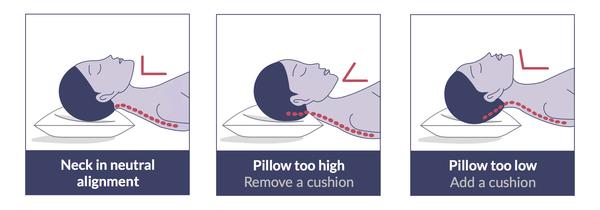
Your sleeping position plays a big role in determining what is the right pillow is for you.
Stomach-sleeping is never recommended, and especially not if you have neck pain. T
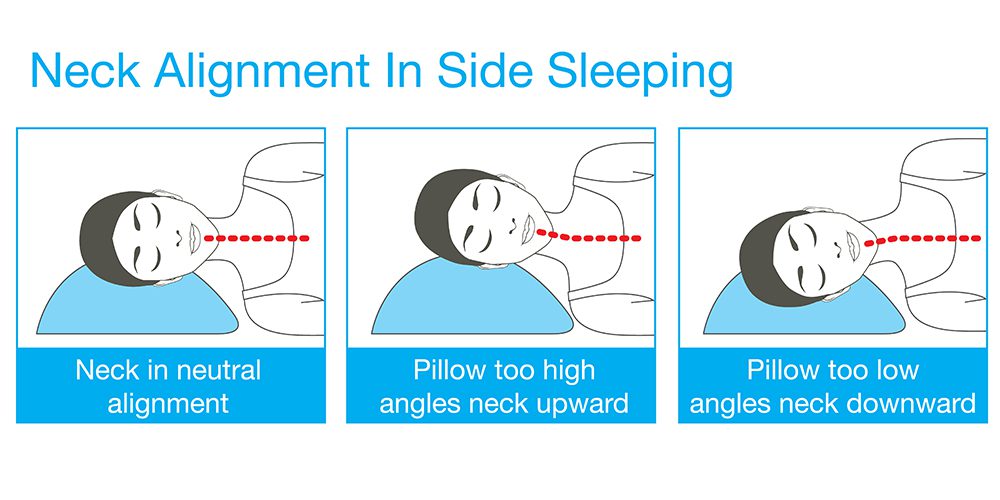
The distance between your mattress and your head is much smaller when you're laying on your back then when you're laying on your side. This means that you need a much-thicker pillow when you're lying on your side than when you're lying on your back.
Most side sleepers use pillows that are too small for them. This doesn't mean you need to go out and buy a brand new pillow. Many times, you can just add a skinnier pillow or even some folded-up towels underneath your existing pillow in order to maintain that neutral neck position.
Once you have found the pillow that is the right size for you, you then need to make sure that the rest of your body is in proper alignment. The area of the body that is most important in relationship to neck pain is our shoulder blades.
The most common issue I see that can contribute to neck pain is elevated shoulder blades. This means that the distance between your shoulder blades and your ears is smaller than it should be. This shortens the muscles of our neck and shoulders and causes them to feel tight and painful the next morning.
Once you are lying in a good, neutral position with your head on the pillow, your next step should be to consciously lower your shoulder blades downward and keep them there. The video above shows how to do this.
When you do this before you go to sleep, and you do it again any time you wake up in the night, you will greatly reduce the tightness and pain in your neck the following morning.
So - at this point, you've found the right pillow for you, you've got your shoulders and the proper alignment, and the last important checkpoint before you go to sleep is the position of your head.
Many of us sleep with our head extended. This causes our chin to jut out far away from our throat. In this position, the muscles at the base of our skull are put in a very shortened position. This can cause these muscles to contract, tighten up and be very sore in the morning.
Not only can this cause pain in the neck, but these muscles are highly connected to headaches. If you find you are waking up with headaches in the morning, this is a "must- fix" for you!
Watch the video below, and I will show you how to fix this.
You're on your way to better sleep and better neck mobility and strength in the morning!
There you have it.
You're all set to develop a new sleeping practice that will give your neck a break - and help you wake up refreshed and with your neck muscles relaxed and ready for a great day!
These three tips will greatly reduce any pain that you have in your neck after sleeping. If you try these tips and you're still having neck pain, I recommend you visit a healthcare practitioner for a proper examination and treatment plan.
If you live in the Tulsa area, Movement Laboratory is here to help resolve any neck pain that these three tips don't take care of. Give us a call at 918-300-4084 and schedule your appointment today!
*We have a "Giving Thanks" new-patient special we're offering for the month of November that gives you $85 off your new patient visit - you'll receive my Assessment and your first treatment for just $65 patient cost!
Don't wait - you can call to schedule today!

I often have patients who come to see me for neck pain. I will do some manual therapy on their neck muscles and adjust some of the joints in their neck -- and they walk out feeling amazing! Then I'll see them a few days later -- and their neck has tightened back up again.
Patients often ask me, "Why is my neck always tight?" I tell them that one of the major contributors to chronic neck pain and tightness is poor breathing mechanics. At this point, they normally look at me like I have two heads. They may say, "Well, I'm alive -- so how can I be breathing wrong?"
In this blog, I'm going to cover how poor breathing mechanics contribute to neck pain and what to do to fix it. (add in a separator line here to note the Blog beginning)
The Body's Ability to Adapt - Good AND Bad
Our bodies are pretty amazing. One thing that makes our body so amazing is its ability to adapt. Without this ability, when we sprained our ankles, we would be confined to a wheelchair. Instead--our body figures out a way to walk without putting weight on our injured ankle - what we would call a limp.
But sometimes this ability to adapt can lead to problems. Imagine if you sprained your ankle when you were 12 -- and your body decided to limp for the rest of your life. Eventually, the changes your body made to not put weight on your injured ankle would start to overload the other areas of your body and possibly lead to pain and injury.
The same thing can happen when we change our breathing mechanics. The primary muscle that's supposed to be used for breathing is the diaphragm. The diaphragm sits at the bottom of our rib cage and is shaped like an upside-down bowl. When the diaphragm contracts, it drops down and creates negative pressure in the chest. That makes us suck air in through our mouth and nose and fills our lungs with precious oxygen.
Even though the diaphragm is our body's primary muscle for breathing, we also have lots of other muscles that are called secondary (or accessory) muscles of breathing. These muscles are supposed to be called upon only in times of great oxygen demand. After vigorous exercise, these secondary muscles help to increase the amount of oxygen coming into the lungs to help us recover from the exertion.
Problems occur when people start to use these secondary muscles of breathing all the time. These muscles are only designed to assist in breathing occasionally, and are not to be used 24/7 while we breathe in and out all day long. These muscles are much smaller than the diaphragm and can fatigue much more easily than the diaphragm.
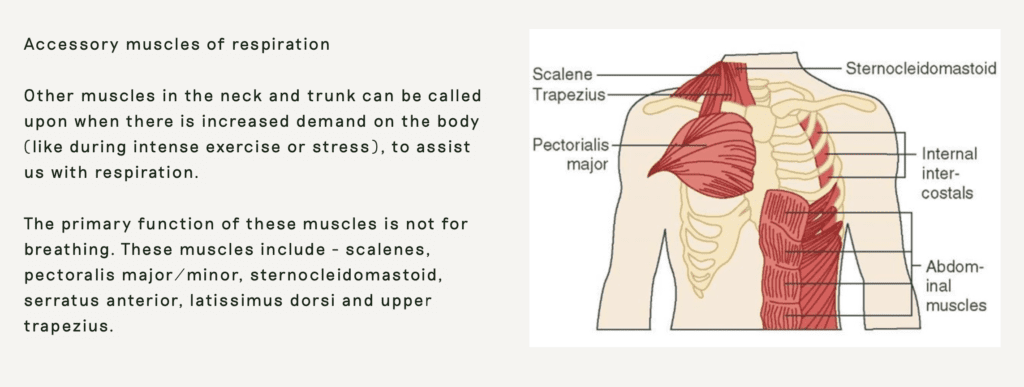
If you look at the picture above, you'll see that it shows these secondary muscles of breathing. Many of them are around our chest and neck. Breathing mechanics that overuse these muscles can lead to tightness and soreness in these areas. The average human breathes 20,000 times a day. So if you use these muscles to breathe all the time, they get a 20,000 rep workout every day. Imagine what your biceps would feel like if you did 20,000 bicep curls every day! They'd probably be pretty sore and tight.
When we primarily use our secondary muscles of breathing, that's called a chest-breathing pattern. Instead of using the diaphragm to drop down and create negative pressure in the chest, we elevate our rib cage to create that negative pressure in the chest. This pattern not only leads to the tightness that I was talking about; it is also a less-efficient breathing pattern that leads to less oxygen entering our lungs.
Why do Most of us Breathe from our Chest, Not our Diaphragm?
So why does this happen in the first place? There are a lot of answers for this.
For many of us, one big reason is simply our culture. When we breathe with our diaphragm, the diaphragm drops down and creates that negative pressure in the lungs -- but what it also does is that it increases the pressure in our belly -- which makes our belly expand.
If you think of every article you've ever read about losing weight, how to dress attractively, or every depiction of an attractive person in our media, you'll be quickly able to note that an expanded belly is never a part of any of those messages about how to look great. From a very young age, we have modeled for us that we must always suck in our bellies -- to appear skinny. This is a very strong cultural message, and in my opinion, is one of the primary underlying reasons for these chest-breathing strategies.
What can we do to change this Breathing Pattern and Start Using our Diaphragm to Breathe?
So now that we know what the problem is, how do we fix it?
FIND Your Diaphragm
The first thing we have to do is get in touch with our diaphragm muscle. Let me give you a great exercise that will help you do just that.

After learning how to feel your diaphragm, you want to go right into learning how to use it to breathe.
Use Your Diaphragm to BREATHE
Lying on your back is the easiest position to use as you first start to practice proper breathing mechanics; that's because it allows most of your muscles to relax since you're not having to resist gravity. But that's not usually a position that we're in much of our day -- so it's important that we also learn to do this same type of breathing in other positions.

If you take the time to work on each of these exercises for two to three weeks, and then move on to the next one listed, I promise you that you'll begin to notice less tension in your neck and chest.
Why not spend 3-10 minutes a day doing this Breathwork to give your neck and chest muscles a new possibility of Relaxing while your diaphragm does the work it was designed to do? You won't regret it!
If you need more help with your neck pain or any other pain, Movement Laboratory is here to help! Give us a call at 918-300-4084 and schedule your appointment today. During the month of November, we are having a special for a free exam on your New Patient visit. That's an $85 value! Don't let pain interfere with your Holidays, come see us today!
